Canon VT, L2 Rangefinder Cameras of 1956
A Description of two innovative new Canon models introduced in 1956
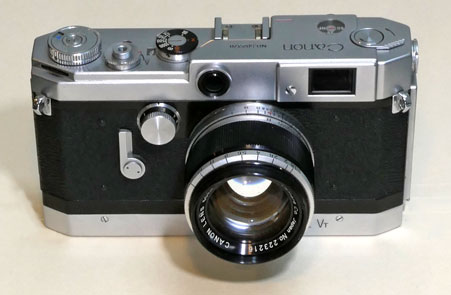
Canon VT of 1956 with a new 1956 Canon 50mm f1.8 lens which was introduced with the Canon VT and L2 cameras
you can see the front lever for the self-timer - the first built into a Canon camera
Introduction of Two New Cameras in 1956
The introduction by Leica of the revolutionary (not too strong a description) Leica M3 in 1954 presented an important challenge to all other camera manufacturers. Although Canon had been working on a new generation of its fine rangefinder cameras, it was not ready for such a major change as was represented by the Leica M3.
Canon VT
The first of these two new cameras was the Canon VT introduced in August 1956. It featured a number of important innovations for Canon rangefinder cameras:
- a greatly improved three mode viewfinder, described below.
- the improved shutter mechanism of the Canon IVSB2.
- for the first time in a Canon camera, a fully opening back for film loading, rather than the more difficult bottom loading of all previous Canons.
- replacement of the Canon flash rail with a compact PC outlet, compatible with many new electronic strobe flashes, and with a surrounding bayonet lock into which a new range of Canon flash units could be attached, compactly.
- a rapid film wind trigger built into the camera base plate obviating the need to attach a Canon Rapid Winder for rapid film advance. And, the sister Canon L2 was to offer the alternative of a camera top lever winder for easy film advance with the thumb.
- for the first time, a self-timer built into the cameera body.
Canon VT Viewfinder and Parallax Adjustment
The viewfinders of the Canon VT and Canon L2 featured improved brightness and offered three viewing positions:
- the "35" position provided a full 35mm view, but without bright lines or parallax correction.
- the "50" postion gave a 70% of lifesize view for the 50mm lens.
- although not parallax corrected in the normal viewfinder, both the Canon VT and L2 had a new feature in the accessory shoe. A pin in the center of the accessory shoe raised and lowered according to the rangefinder focus. This pin linked to new V-type Canon accessory finders. The finders would raise and lower, moved by the pin, as the camera was focused, allowing them to correct automatically for parallax. This was an advanced feature unique to Canon.

the parallax adjustment pin located in the accessory shoe which links to the matching pin in the bottom of the Canon V-type accessory finder

two Canon V-type adjustable finders: 28mm and 100mm showing pivoting base which slides into the accessory shoe,
with arrows pointing to parallax adjustment pins which link to the corresponding pin in the accessory shoe
Canon VT trigger film advance
Since 1951, Canon had promoted rapid film winding using a trigger on the camera base. Originally this was in the form of an accessory: the Canon Rapid Winder. The Canon VT now had the rapid winding mechanism built into the camera base plate.
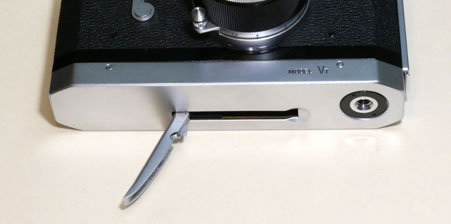
Canon VT trigger film winder built into the camera base
Canon L2 Rangefinder
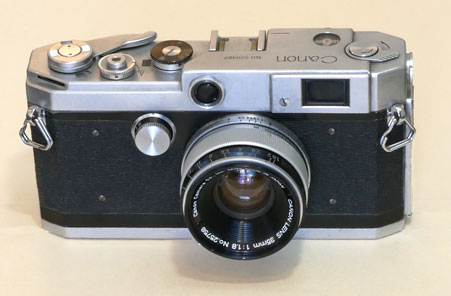
Canon L2 of 1956 with the new Canon 35mm f1.8 lens
Although Canon had been promoting rapid film advance with a base plate lever winder, they also had recognized the growing preference for a camera top lever winder among active photographers. Consequently, they launched the Canon L2 with thumb lever film advance some six months after the Canon VT. The Canon L2 had all the new features of the Canon VT: improved three mode viewfinder, a fully opening back for film loading, replacement of the Canon flash rail with a compact PC outlet, compatible with many new electronic strobe flashes, and with a surrounding bayonet lock into which a new range of Canon flash units could be attached, compactly. The flash connection was a marked improvement over the large flash rail of previous synchronized Canons.
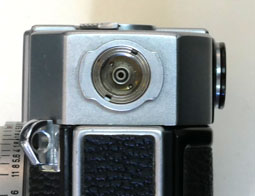
Canon bayonet flash PC outlet with locking collar
Canon VT and L2 Flash Selection
The VT and L2 were synchronized for both flash bulb and electronic strobe flash. The selection between these was performed by moving a small lever located next to the high speed shutter dial.
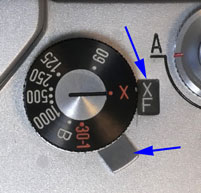
the small flash selector switch and the window showing which synchronization
in this case, electronic strobe flash - XF - has been selected
The Canon L2 was one of the few Canon rangefinder cameras which identified its model number on the camera base plate.

Canon L2 base plate with identification
New 1956 Canon Lenses
As shown in the picture at the top of this page, Canon revised the 50mm f1.8 lens in a new lighter alloy body with a new black focusing collar. With the launch of the Canon VT and L2, Canon also introduced two faster Canon lenses: the 50mm f1.2 and the 35mm f1.8.
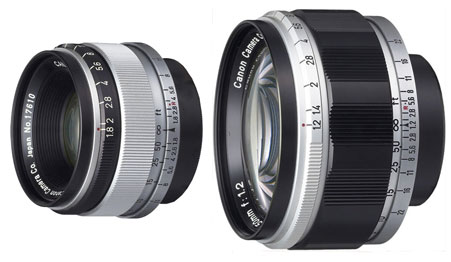
the 1956 Canon 35mm f1.8 and 50mm f1.2
Canon featured the 50mm f1.2 in its advertising and the promotion for both the VT and the L2. It was the fastest lens of its time on any of the leading 35mm cameras. Contemporary Nikons and Leicas offered 50mm f1.4 lenses.
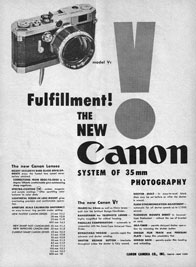
1959 Canon VT advertisement featuring the 50mm f1.2 lens
Interestingly, the company Zunow Kogaku Kogyo K.K. - ズノー光学㈱ - or Zunow Optical Industry Co., Ltd. was an independent lens and camera manufacturer in the mid-1950s. Zunow had introduced a 50mm f1.1 lens in about 1954. Zunow offered this lens in both M39 screw mount and Contax/Nikon bayonet mount versions. This was the fastest 35mm camera lens of its era. However, it was produced in very small numbers and was very expensive. The company was later purchased by Nikon. This was the only 35mm camera lens faster than the Canon 50mm f1.2, but was produced in very small quantities - perhaps 100 to 200 units.
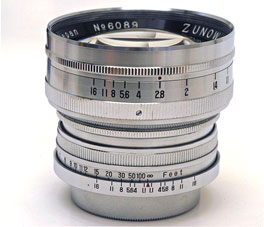
the Zunow 50mm f1.1 lens
Sales of the Canon VT and L2
Both the Canon VT and the Canon L2 were sold for less than 12 months: April 1956 to February 1957 for the VT and November 1956 to summer 1957 for the L2. Also, Dechert states the the L2 was sold primarily in the domestic Japanese market. Their sales numbers were consequently relatively low: 15,575 for the VT and 7,250 for the L2. Nevertheless, these were well-made cameras with significantly improved features, and were launched with three important new lenses: the improved 50mm f1.8, the fast new 50mm f1.2 and the 35mm f1.8. Overall this was a success for Canon's regularly improving technology.
You can click on the links in the table below to consult other pages of the canonrangfinder.org site.
| Navigation: Click Below to Jump to Desired Subject Page | ||
|---|---|---|
| Canon Rangefinder Cameras - 1 | Canon Rangefinder Cameras - 2 | Canon Rangefinder Lenses |
| Canon S | Canon IVSB2 | Canon 19mm |
| Canon J | Canon IIS2, IID2, IIF2 | Canon 25mm |
| Canon NS | Canon VT, Canon L2 | Canon 28mm |
| Canon JS | Canon L1, L3 | Canon 35mm |
| Canon J-II | Canon VT Deluxe | Nikkor 50mm |
| Canon S-II | Canon VL, VL2 | Canon 50mm |
| Canon IIB | Canon VI-L, VI-T | Canon 85mm |
| Canon III, IIC, IV | Canon P | Canon 100mm |
| Canon IIIA, IVF, IVS | Canon 7 | Canon 135mm |
| Canon IIA, IID, IID1 | Canon 7s | Canon 200mm-1000mm |
| Canon IVSB | Minolta Rangefinders | Minolta Lenses |
| Canon IIF, IIS | Other Rangefinders | other M39 lenses |
| Go to canonrangefinder.com home page | ||
Any additions or corrections to these pages would be welcome simply by contacting this site as shown at the foot of this page .
Footnotes:
1 Dechert, Peter. Canon Rangefinder Cameras 1933-1968. Hove Collectors Books. West Sussex, United Kingdom. 1985. ISBN 0-906447-30-5.
Peter Dechert's book is the most important expert source of information regarding Canon Rangefinder Cameras.
2 Kitchingman, Peter. Canon M39 Rangefinder Lenses 1939-1971. A Collector's Guide. Published by Peter Kitchingman. Perth, Australia. 2008. ISBN 978-0-646-48144-9.
Peter Kitchingman's book is the definitive study of the more than three decades of M39 format camera lenses developed for Canon Rangefinder Cameras.
3 Nostalgic Canon Camera Book. 懐かしいキヤノン EI Publishing Co. Ltd. Tokyo, Japan. June 2003.
Peter Kitchingman's book is the definitive study of the more than three decades of M39 format camera lenses developed for Canon Rangefinder Cameras.
4 "Canon Camera Museum" history website. https://global.canon/en/c-museum/history/ published by Canon, Inc. accessed in 2019.
5 Rajner, Hans P. (author), John Wade (editor). Leica Copies. Classic Collections Publications. London, UK. ISBN 13: 9781874485056
Hans P. Rajner's book is an excellently detailed and carefully researched study of camera from around the world which used the Leica M39 lens mount and the same lens to film plane distance.
7 Dechert, Peter. Canon Single Lens Reflex Cameras 1959-1991. Historical Camera Publications. Yakima, Washington. 1992. ISBN 1-879561-04-2.
8 Tomlinson, Shawn M. The Film Photography Book. Lulu Pulbications. 2016. ISBN: 9781365263972
9 Sartorius., Ghester. Identifying Leica Lenses. Classic Camera 19. Tokyo, Japan. 2001. ISBN 4-257-12029-0
10 website http://www.nicovandijk.net/rflensmatrix.htm consulted 2019.
11 O'Reagan, Douglas M. Allied Exploitation of German Science after World War II. Johns Hopkins University Press. Baltimore, Maryland. 2019. ISBN 9781421428888
12 website www.canonrangefinder.servehttp.com consulted 2008.
13 Minolta expert Andrea Aprà has posted information on minoltarangefinders group and other groups and further detailed information by email. (thanks Andrea !)
14 website http://www.collection-appareils.fr/objectifs/ consulted 2019.
15 Small, Marc James. Non-Leitz Leica Thread-Mount Lenses. Wittig Books. Hückelhoven, Germany. 1997. ISBN 3-930359-47-2.
16 the Nikon Corporation website: https://imaging.nikon.com/history/ consulted 2019.
17 p 152. Ray, Sidney F. Photographic Lens ISBN 9780240510323
18 website http://www.rokkorfiles.com/Lens%20History.html accessed 2019
If you have any comments or questions about this Canon Rangefinder site, please e-mail me (Larry Huffman) at e-mail address: [email protected]